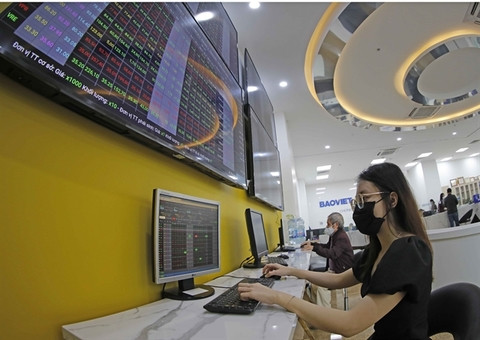
Investors conduct transactions at Bao Viet Securities' office in Ha Noi. — VNA/VNS Photo
The Vietnamese stock market ended flat last week amid the effects of domestic and foreign events. However, the market was more positive than the global one thanks to net inflows from foreign investors.
Accordingly, they net bought for the sixth consecutive week.
Even though the net buying value from foreign investors reduced over the previous two sessions, they still net bought nearly VND2 trillion (US$84.7 million) worth of shares, mainly in securities stocks.
VNDirect Securities Corporation said that the emerging and frontier markets’ exchange traded funds (ETFs) net bought more than 1.7 trillion Vietnamese shares in just one month.
From around mid-November, the Vietnamese stock market experienced a strong recovery from the long-term bottom, boosted by great motivation from foreign investors.
Besides the return of disbursement of large active funds such as Dragon Capital and VinaCapital, foreign capital inflows into the market via the ETF channel also witnessed positive movements.
Funds, including Fubon ETF, FTSE Vietnam ETF, V.N.M ETF, and especially iShares MSCI Frontier and Select EM ETF, are continuously net buying. The IShares MSCI Frontier and Select EM ETF are ETFs that specialise in investing in frontier and emerging markets.
Since November 15, iShares MSCI Frontier and Select EM ETF have net bought approximately $234 million, equivalent to VND5.850 trillion.
The proportions of Vietnamese stocks in the portfolio are approximately 30 per cent with 44 stocks. Thus, it is estimated that with $234 million of net buying value from iShares MSCI Frontier and Select EM ETF in the past month, about $70 million has been disbursed to buy Vietnamese stocks.
Clearly, ETF capital inflows have poured into the market as the valuation of Vietnamese shares has dropped to historic lows after a period of continuous deep decline. The market prices of many large-cap stocks also plunged to low levels, stimulating the bottom-fishing cash flow of foreign investors.
Meanwhile, capital flows have shown signs of returning after the period of withdrawing in 2020-21, showing that foreign investors' confidence in frontier and emerging areas is improving. With the driving force, Viet Nam is said to have the most positive prospects as it is leading the frontier market basket with a proportion of about 30 per cent, said VNDirect.
In fact, foreign investors made a net purchase on the stock market in the context that the Vietnamese macro-economic situation is still very positive. The World Bank (WB) recently assessed that the country will be the leading economy in the East Asia-Pacific region with a growth rate of 7.2 per cent in 2022 and 6.7 per cent in 2023.
Andrea Coppola, World Bank chief economist in Viet Nam, said that Viet Nam’s positive economic results in 2022 are driven by four main factors.
Firstly is the export driving force, which has been very strong in the past, as it has shown resilience even in times of crisis because of the COVID-19 pandemic, with exports of processed and manufactured products being the main growth motivation.
The second is domestic demand. Domestic consumption and retail sales are the main growth drivers in 2022. It is presented by the fact that retail sales in October 2022 recorded a growth of about 17 per cent over the same period last year.
“We assess that Vietnamese domestic demand is expected to be impacted by rising domestic inflation in the future, but it will continue to contribute positively to the economic growth outlook in 2023,” said Coppola.
According to the WB’s economist, the third driving force is investment.
In the first 11 months of the year, disbursement of foreign direct investment (FDI) increased by more than 15 per cent year-on-year.
Last but not least, as the COVID-19 pandemic had a strong impact on the Vietnamese economy last year, especially in the third quarter of 2021, the outstanding economic performance recorded in 2022 is also the result of the low starting point. — VNS